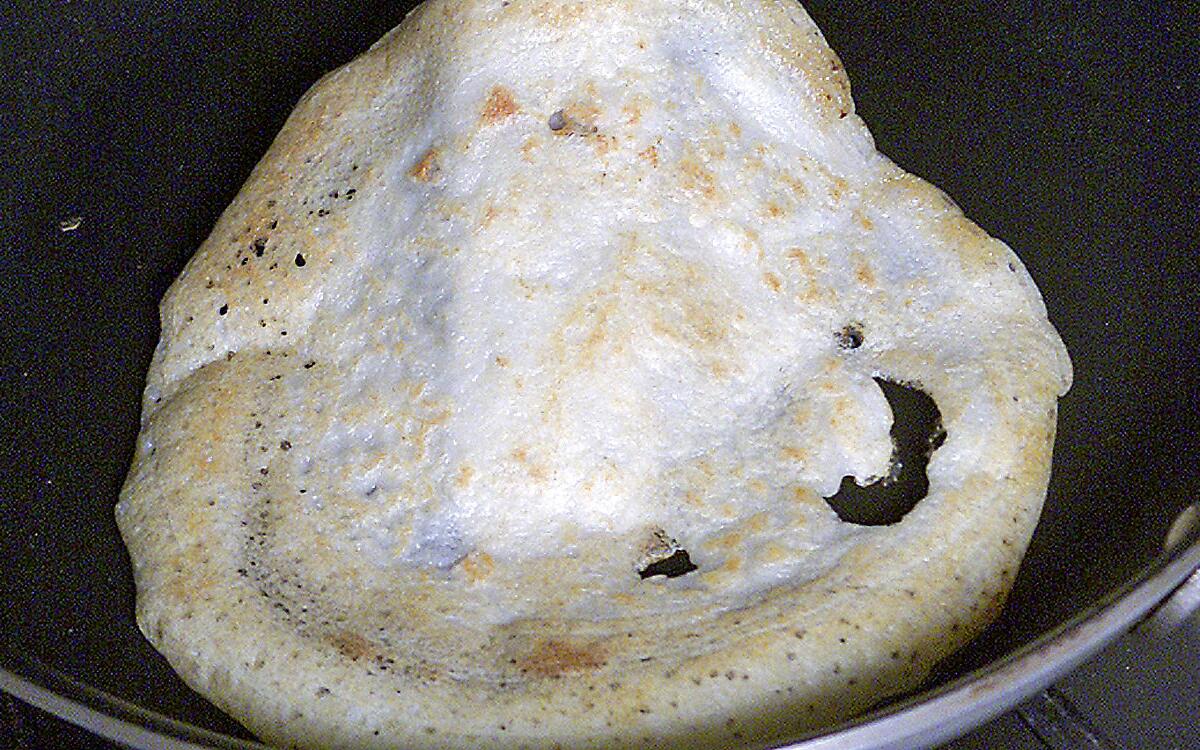Sada dosa

The dosa is a hugely versatile food. In India, it can be a light snack or a meal in itself. It can be made light and lacy or thick and substantial. It can take a simple five minutes to prepare or a marathon 24 hours. Its batter can be refrigerated for a week and still not lose its taste. And it can be made in a hundred different ways, to suit a hundred different tastes.
All of this I know from personal experience. When I was growing up in India, we used to have the most marvelous summer vacations at my grandparents’ rambling house. It seemed to me that at any given time there were a hundred people there--uncles, aunts, cousins, second cousins, widowed great aunts, neighbors and a stray friend or two.
One of the simplest ways of feeding the tribe was to prepare gallons of dosa batter, with gallons of sambar and coconut chutney to go with it. The dosa batter and chutney would be ground in an oversized version of a stone mortar and pestle. Even simpler was making a dosa that could be eaten with just homemade hot mango or bamboo shoot pickles, or with date syrup or honey.
The women of the house would take turns standing over the hot griddles to keep the dosas coming. The children, once they were done eating, were recruited to yo-yo between the dining table and the kitchen with the fresh batches. That we needed urgent refueling for this arduous task was taken as a given, and a handful of banana chips or a cream of wheat ladoo did absolute wonders to keep up our strength.
The secret of the perfect dosa lies primarily in the making of the batter. The sourdough dosa, which forms the basis for the masala dosa and is probably the most labor-intensive of dosas, is made with rice and the legume urad dal (a kind of black lentil). It has to be blended to the perfect consistency and fermented correctly in order to get it right. The warm weather in south India speeds up the fermentation process, but in more temperate climes, it can take up to 12 hours.
It’s a good idea to prepare a small amount of batter to begin with. Make half a batch to start. But even with a perfect batter, the crispy mile-long masala dosa served in restaurants does take a bit of practice--and griddle space--to achieve.
But don’t worry. You don’t need to make it a mile long. It need not be a perfect circle, and it’s allowed to be more than a millimeter thick--even if you’re not cooking for hundreds of hungry relatives.
Wash the dal and rice separately until the cloudiness in the water disappears. Soak them separately in tepid water to cover at room temperature until the dal expands and softens and the rice takes on a white opaqueness, about 4 hours. Drain and reserve the liquid.
Grind each separately in a blender, using enough of the reserved liquid to make a smooth consistency. The batter for both should be very thick, so add as little water as possible. To check the consistency, take a small amount of batter and rub it between your index finger and thumb. You should feel no grittiness.
Empty both batters into an oversized bowl (the batter will double when fermented), using more of the reserved water to wash out the stubborn bits stuck in the blender. The batter should now be of the consistency of pancake batter that is neither runny nor lumpy when dropped. Add the salt and mix thoroughly.
Cover the bowl loosely with plastic wrap and place it in a warm oven (For a gas oven, heat from the pilot light should be enough; for an electric oven, heat at 225 degrees 5 minutes then turn it off. A temperature of 85 to 90 degrees is essential to the fermentation process.). Leave it to ferment overnight (at least 8 hours). South India feels like an oven most months of the year, so one isn’t really needed there for this purpose.
The next day, remove the bowl from the oven and mix thoroughly again. It should have doubled in volume and become thick and foamy. It should also smell slightly sour. The batter is now ready for frying; it can be covered and refrigerated at this stage if the dosas are not going to be prepared at once.
Heat a nonstick griddle or frying pan over medium-high heat. Lightly oil the surface, seasoning the pan. Blot off any excess oil with a bunched-up paper towel.
Ladle 1/4 cup of batter into the center of the hot pan or griddle and immediately, beginning at the center, spread the batter out in a circular motion, using the bottom of the ladle, until the batter is spread out thinly. Spoon a little oil around the edges and cook, covered.
Uncover after about 30 seconds. Small holes should have formed on the surface of the dosa and its edges should have separated from the pan. Leave for 30 more seconds before lifting one side gently and folding it over the other. It should be crisp at this point. To get it crackly-crisp, add more oil around the edges after spreading the batter.
Best served immediately with Coconut Chutney and sambar.
Get our Cooking newsletter.
Your roundup of inspiring recipes and kitchen tricks.
You may occasionally receive promotional content from the Los Angeles Times.















